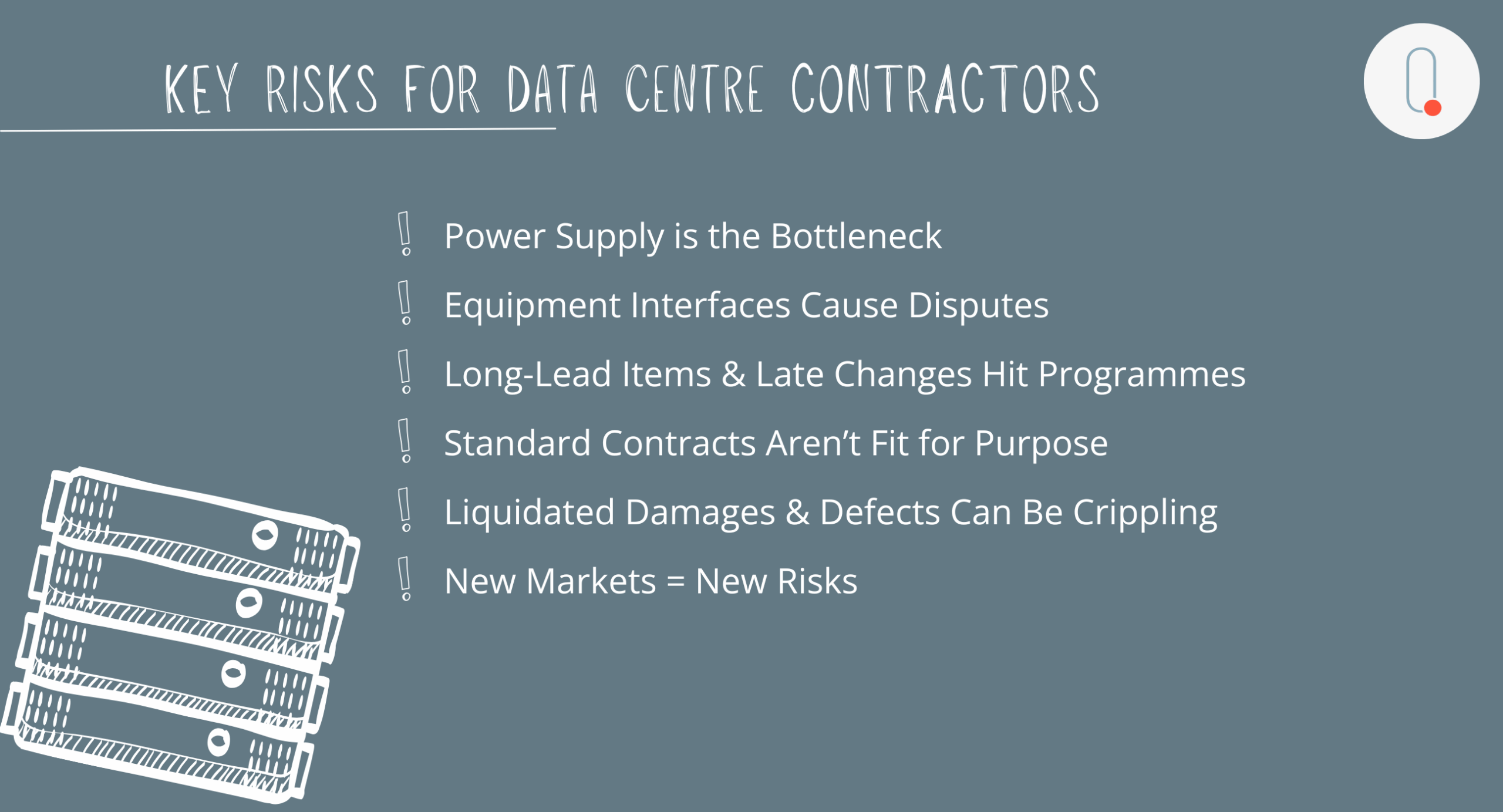With over £250 billion in data centre (DC) investment forecast globally over the next five years, demand for resilient, scalable, and energy-intensive infrastructure is rising fast. But so too is the complexity – and the potential for disputes.
Following a recent industry workshop on data centre disputes, we’ve compiled the key risks contractors need to be aware of, along with actionable steps to prepare for the next wave of projects.
1. Power Supply is the First Bottleneck
Modern DCs require uninterrupted 24/7 power. But with grid capacity tightening – especially in urban hubs and growing European markets – developers are increasingly investigating private generation options.
- This introduces engineering and legal complexity. Contractors must work with systems outside of their control and experience.
- Delays in grid connections or temporary solutions often lead to claims and scope creep.
What to do
Get clarity on power access early. If private generation is involved, ensure roles, specs, and commissioning responsibilities are contractually watertight.
2. Equipment Interfaces Cause Major Disputes
Clients often supply their own specialist equipment – generators, cooling systems, UPS units – which contractors must install and commission.
- The problem? Responsibility is blurred. If the kit fails, was it a procurement issue, an install error, or a commissioning fault?
- This is one of the most common sources of late-stage disputes.
What to do
Push for defined accountability in the contract. If you didn’t procure it, limit your liability to installation and commissioning only, where possible.
3. Long-Lead Items and Late Changes Hit Programmes
DC projects are heavily front-loaded with long-lead items. Especially in MEP.
- When this equipment arrives late or incomplete, progress stalls.
- Add in last-minute design changes (e.g. to meet planning, acoustic, or energy recycling requirements), and projects fall behind.
What to do
Build in float around key kit delivery and maintain a close working relationship with suppliers. Factor mid-project change into programme and risk models.
4. Standard Contracts Aren’t Fit for Purpose
JCT Design & Build and FIDIC Yellow remain popular, but they don’t reflect the realities of DC construction.
- They often fail to deal with complex equipment interfaces, commissioning responsibilities, and performance testing.
- Bespoke amendments are common – but risk is often still loaded unfairly onto the contractor or create situations where the contractor fails to correctly understand their obligations.
- Scope gab between Main Contractor and Subcontractor contract forms is leading to disputes in the supply chain.
What to do
Scrutinise contract amendments closely. Consider pushing for better risk allocation where you as the contractor do not feel like you are entirely in control of the scope or risk that the employers are trying to pass on. Identify a contract form that works across the entire supply chain with realistic risk allocations.
Need help with your project?
If you’re bidding, planning, or midway through a data centre project and want support reviewing your commercial risk exposure, or assistance with contract administration, Quantum Project Control are here to help.
5. Liquidated Damages and Defects Can Be Financially Crippling
In a DC context, downtime = major tenant losses. Service Level Agreements often include penalties for outages, which landlords try to pass down the chain.
- LD clauses in these builds are frequently aggressive.
- Defect claims, especially from latent faults in MEP or power systems, often surface well after practical completion.
What to do
Use legal review to limit LD exposure to realistic, capped amounts. Ensure defect insurance is in place. Review whether Delay in Start-Up (DSU) or All-Risks policies provide meaningful cover.
6. The Global Shift: New Markets, New Risks
As capacity dries up in Tier 1 markets, clients are shifting focus to countries like Poland and Spain – often where supply chains and local contracting knowledge are thinner.
- UK or European contractors are being invited into these markets – but must assess political, logistical, and energy-related risks.
- Clients are also trialling modular nuclear, underwater DCs, and new cooling technologies.
What to do
Assess local partner capability carefully. Consider joint ventures or alliances with regional experts. And ask hard questions about infrastructure readiness before pricing a job.
Complexity Needs Clarity
Data centre projects are no longer just “big sheds with cables.” They are engineering-first builds with mission-critical infrastructure, high-performance demands, and tight risk tolerances.
Too often, disputes arise not from failure – but from unclear expectations, rushed coordination, and contracts that don’t reflect the real risk profile.
Don’t wait for a dispute to sharpen your risk strategy. Early engagement, well-drafted contracts, and clarity on commissioning and supply chains can save millions.
Disclaimer
Quantum Project Control is not a law firm and does not provide legal advice. This article is for general information purposes only and should not be relied upon as legal advice. For guidance on specific issues, please consult a qualified legal professional.


